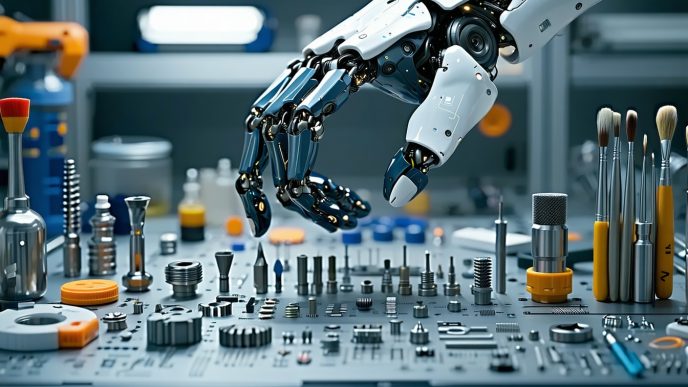Exploring Robot Interaction with the World
Importance of Sensory Feedback
Sensory feedback plays a critical role in how robots interact with their environment. It allows them to perceive and respond to various external stimuli, which is vital for tasks that require precision, such as gripping and manipulation. Effective sensory feedback enables robots to adjust their actions based on real-time information, enhancing their ability to handle a wide range of objects and perform complex tasks effectively.
When robots lack proper sensory feedback, they may struggle with tasks that require sensitivity, such as adapting their grip based on the texture or weight of an item. The integration of advanced sensory systems, particularly tactile sensors, enables robots to achieve a level of dexterity that is essential for performing intricate functions in various applications. For a deeper understanding of how these sensors contribute to manipulation, refer to our article on robot gripping and manipulation.
Overview of Tactile Sensors
Tactile sensors are specialized devices that allow robots to collect data on physical interactions. These sensors are capable of detecting pressure, texture, and force, enabling robots to respond appropriately to different conditions. The use of tactile sensors in robot hands significantly improves their ability to grip, manipulate, and navigate through their surroundings.
Tactile sensors can be categorized based on their working principles, which influence their functionality and suitability for various applications. Understanding the different types of tactile sensors is essential for making informed decisions about robot design and functionality. Below is an overview of the key features of different tactile sensors:
| Sensor Type | Principle of Operation | Sensitivity | Typical Applications |
|---|---|---|---|
| Resistive Sensors | Measure change in resistance when pressed | Moderate to high | Basic gripping tasks, simple object manipulation |
| Capacitive Sensors | Measure capacitance change due to pressure | High | Advanced object recognition, fine manipulation |
| Piezoelectric Sensors | Generate voltage from mechanical stress | Very high | Dynamic force measurement, safety applications |
For more insights into the applications and integration of tactile sensors in various robotic systems, visit our respective articles on dexterous robot hands and robot grasping technology. The implementation of these sensors is integral to enhancing the capabilities of robots, allowing them to perform tasks with greater accuracy and efficiency.
Types of Tactile Sensors
Understanding different types of tactile sensors is critical for enhancing robotic interactions with their environment. These sensors provide essential information that allows robots to grip, manipulate, and perform complex tasks with varying levels of dexterity. Below are the main types of tactile sensors found in robot hands: resistive sensors, capacitive sensors, and piezoelectric sensors.
Resistive Sensors
Resistive sensors measure pressure applied to their surface by detecting changes in electrical resistance. These sensors can be made from conductive materials that change resistance when compressed. They are widely used in robotic applications for tasks requiring accuracy in sensing force.
| Type of Application | Sensitivity Range | Advantages | Disadvantages |
|---|---|---|---|
| Light Touch | 0.1 – 10 N | Simple design, Cost-effective | Limited durability |
| Heavy Gripping | 10 – 100 N | Good reliability in force measurements | Less sensitivity to texture changes |
Resistive sensors are effective for robot gripping and manipulation, although they may not provide detailed information on texture or surface characteristics.
Capacitive Sensors
Capacitive sensors function by measuring changes in capacitance caused by the proximity of an object. When a surface comes into contact with the sensor, it alters the electric field, which is then converted into a measurable signal. These sensors are known for their sensitivity and ability to detect fine textures.
| Type of Application | Sensitivity Range | Advantages | Disadvantages |
|---|---|---|---|
| Surface Texture | 5 – 50 μm | High sensitivity to small changes | More complex circuitry |
| Proximity Sensing | 0 – 10 mm | Quick response time | Can be affected by environmental conditions |
Capacitive sensors play an important role in robot manipulation tasks and assist in identifying objects based on texture.
Piezoelectric Sensors
Piezoelectric sensors generate an electric charge in response to applied mechanical stress. This quality allows them to detect rapid changes in pressure and vibrations. They are particularly useful in applications where force changes rapidly, making them suitable for dynamic tasks.
| Type of Application | Sensitivity Range | Advantages | Disadvantages |
|---|---|---|---|
| Force Measurement | 1 – 1000 N | Excellent temporal resolution | More sensitive to noise |
| Vibration Sensing | 0.1 – 10 g | High-frequency response | Requires calibration |
Piezoelectric sensors enhance gripping strength in robots and are effective in tasks requiring quick adjustments to grip forces.
By exploring these types of tactile sensors in robot hands, enthusiasts and students can gain insight into the technology that impacts how robots perform with precision. Understanding the interplay between these sensors can fuel advancements in robot tool usage and future of robotic manipulation.
Applications of Tactile Sensors
Tactile sensors play a crucial role in how robots grasp, manipulate, and interact with objects in their environment. Understanding the applications of these sensors provides insight into the complexities of robotic interactions.
Gripping and Manipulation Tasks
Tactile sensors are fundamental for effectively executing gripping and manipulation tasks. They provide robots with the ability to detect the shape, weight, and surface properties of objects, allowing for smooth manipulation without damaging items. The feedback from these sensors informs the robot how much pressure to apply during gripping, helping to avoid crushing delicate objects while maintaining a secure hold.
| Sensor Type | Sensitivity Level | Ideal Application |
|---|---|---|
| Resistive | Moderate | General gripping tasks |
| Capacitive | High | Handling delicate objects |
| Piezoelectric | Very High | Dynamic gripping scenarios |
Advancements in tactile sensors enable robots to perform complex tasks, such as assembling components or performing surgery. For more on how robots utilize these technologies, refer to our article on robot gripping and manipulation.
Object Recognition and Classification
Tactile sensors also facilitate object recognition and classification. Robots equipped with these sensors can assess the physical characteristics of an object, such as its hardness, texture, and shape. This information allows robots to distinguish between different items, which is critical for tasks like sorting or handling multiple objects.
Using tactile feedback, robots can build a comprehensive understanding of their environment. This capability enhances their efficiency in performing various tasks, such as selecting appropriate tools in assembly or categorizing similar objects in warehouse settings.
| Tactile Feedback Type | Recognition Efficiency | Use Case |
|---|---|---|
| Surface Texture | High | Classifying materials |
| Weight Distribution | Moderate | Sorting packages |
| Shape Recognition | High | Identifying components |
For insights into how robots utilize tactile sensors for object recognition, check out our article on robot manipulation tasks.
Safety and Collision Avoidance
Integrating tactile sensors within robotic systems significantly enhances safety and collision avoidance. These sensors enable robots to perceive proximity to objects, preventing accidental collisions that could damage both the robot and its environment. When a tactile sensor detects unexpected resistance or contact with an object, it allows the robot to respond appropriately, adjusting its movements or halting altogether.
The deployment of tactile sensors in this capacity contributes to safer interactions in environments where humans and robots coexist, such as manufacturing floors or homes. Ensuring robots can react to physical objects in real-time makes them more adaptable and reliable in shared spaces.
| Application | Sensory Response Time | Impact |
|---|---|---|
| Preventing Collisions | Immediate | High |
| Adjusting Tool Angles | Quick | Medium |
| Analyzing Surroundings | Variable | High |
For more on how robots enhance safety through tactile feedback, explore our article on adaptive gripping in robots.
Incorporating tactile sensors in robotic hands allows for greater functional versatility, which is essential for effective interaction with the world. Each application highlights the importance of tactile sensing technology in the ongoing evolution of robotics.
Integration of Tactile Sensing in Robot Hands
The integration of tactile sensors in robot hands plays a crucial role in their ability to interact effectively with the environment. This section discusses how robots utilize these sensors to detect pressure, texture, and force, contributing to enhanced manipulation and gripping capabilities.
How Robots Sense Pressure
Robots equipped with tactile sensors have the ability to measure pressure exerted on their hands. This capability is essential for performing tasks that require precise gripping and manipulation. Sensors can provide data on the strength of the grip, enabling robots to handle objects without causing damage.
The pressure sensing can be categorized into two main types:
| Sensor Type | Pressure Range | Application |
|---|---|---|
| Resistive Sensors | 0 – 10 N | General gripping and lightweight object handling |
| Piezoelectric Sensors | 0 – 50 N | Handling delicate or fragile items |
By understanding the pressure applied, robots can adjust their grip and improve their performance in robot manipulation tasks.
How Robots Sense Texture
The ability to sense texture allows robots to differentiate between various materials and surface finishes. Tactile sensors can analyze the surface characteristics of objects, which informs the robot how to interact with them. This is particularly important in applications that require careful handling, such as sorting or packing goods.
Robots often use:
| Technology | Texture Sensitivity | Typical Applications |
|---|---|---|
| Capacitive Sensors | Sensitive to surface variation | Surface recognition and quality assessment |
| Tactile Array Sensors | Detailed mapping of surface undulations | Advanced gripping and manipulation tasks |
The data gathered from texture sensing can aid in robot gripping and manipulation tasks, enabling more nuanced interactions with different objects.
How Robots Sense Force
Force sensing is integral to ensuring that robots can execute tasks with the necessary strength and precision. Tactile sensors help robots detect the force being applied, which can prevent damage to both the robot and the object being manipulated.
Force can be measured using:
| Sensor Technology | Force Range | Uses |
|---|---|---|
| Strain Gauge Sensors | 0 – 100 N | Heavy lifting, precise force application |
| Load Cells | Up to 500 N | Industrial applications and heavy object handling |
By monitoring the force applied, robotic systems can adapt their actions, making them more effective in tasks requiring gripping strength in robots and precise handling.
The integration of tactile sensors in robot hands not only enhances their interaction with the physical world but also contributes to the evolution of adaptive gripping in robots and the future of robotic manipulation. Understanding these sensing mechanisms is essential for advancing robot technology.
Challenges and Advances in Tactile Sensing
As the field of robotics evolves, the use of tactile sensors in robot hands becomes increasingly crucial for effective interaction with various objects and environments. However, several challenges remain in advancing tactile sensing technology.
Overcoming Sensing Limitations
One of the primary challenges in tactile sensing is the limitation of current sensor technologies, which can hinder a robot’s ability to accurately perceive and interpret physical interactions. Many tactile sensors struggle with issues such as sensitivity, resolution, and responsiveness. For instance, certain sensors may not effectively distinguish between light touches and heavier forces, making it difficult for robots to adapt to diverse gripping scenarios.
To address these limitations, researchers are focusing on developing sensors that can provide higher resolution and can operate effectively across a range of conditions. Advanced materials, like flexible electronics and nanomaterials, are being explored to enhance the performance and durability of tactile sensors.
| Limitation | Impact | Potential Solutions |
|---|---|---|
| Low sensitivity | Inability to detect light touch | Utilize advanced materials |
| Poor resolution | Difficulty in distinguishing textures | High-resolution sensor arrays |
| Limited force range | Risk of damaging delicate objects | Multi-dimensional sensing systems |
Enhancing Sensory Feedback
Enhancing sensory feedback is another critical area of focus in the development of tactile sensors for robotic applications. Effective feedback ensures that robots can adjust their grip and manipulation strategies in real-time based on environmental changes. Current sensors often provide limited feedback, which may not adequately represent the complexities of physical interaction.
To improve sensory feedback, developers are investigating the integration of multiple sensing modalities. By combining tactile sensors with other types of sensors, such as visual and auditory sensors, robots can gain a more holistic understanding of their interactions. This fusion of data can significantly improve a robot’s ability to perform detailed tasks like robot manipulation tasks.
Future Trends in Tactile Sensing Technology
The future of tactile sensing technology holds promising trends that will shape the capabilities of robotic systems. As robotics continues to advance, several key developments are expected:
-
Soft Robotics: The rise of soft robotics, which emphasizes flexibility and adaptability, will likely lead to the creation of tactile sensors that mimic natural human touch. These sensors can perform complex tasks more efficiently, such as adaptive gripping in robots.
-
Artificial Intelligence Integration: The incorporation of AI into tactile sensing will enable robots to learn and adapt their behaviors based on sensory input. With AI, robots can analyze data from their tactile sensors to improve their performance over time.
-
Miniaturization of Sensors: Ongoing research aims to create smaller, more compact tactile sensors that can be integrated into various robotic applications, enhancing dexterity and allowing for more versatile designs, particularly in dexterous robot hands.
As robots continue to evolve, advancements in tactile sensor technology will play a critical role in enhancing their ability to grip objects with precision and perform intricate tasks effectively. For detailed insights on how tactile sensors improve robot performance, explore our article on robot grasping technology and learn more about the future of robotics with the future of robotic manipulation.















